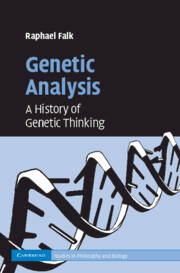Book contents
- Frontmatter
- Contents
- List of figures
- Acknowledgments
- Introduction
- PART I FROM REPRODUCTION AND GENERATION TO HEREDITY
- PART II FAKTOREN IN SEARCH OF MEANING
- PART III THE CHROMOSOME THEORY OF INHERITANCE
- PART IV GENES AS THE ATOMS OF HEREDITY
- PART V INCREASING RESOLVING POWER
- PART VI DEDUCING GENES FROM TRAITS, INDUCING TRAITS FROM GENES
- PART VII WHAT IS TRUE FOR E. COLI IS NOT TRUE FOR THE ELEPHANT
- 17 Extending hybridization to molecules
- 18 Overcoming the dogma
- 19 Dominance
- 20 Populations evolve, organisms develop
- Concluding comments
- Bibliography
- Index
20 - Populations evolve, organisms develop
Published online by Cambridge University Press: 07 August 2009
- Frontmatter
- Contents
- List of figures
- Acknowledgments
- Introduction
- PART I FROM REPRODUCTION AND GENERATION TO HEREDITY
- PART II FAKTOREN IN SEARCH OF MEANING
- PART III THE CHROMOSOME THEORY OF INHERITANCE
- PART IV GENES AS THE ATOMS OF HEREDITY
- PART V INCREASING RESOLVING POWER
- PART VI DEDUCING GENES FROM TRAITS, INDUCING TRAITS FROM GENES
- PART VII WHAT IS TRUE FOR E. COLI IS NOT TRUE FOR THE ELEPHANT
- 17 Extending hybridization to molecules
- 18 Overcoming the dogma
- 19 Dominance
- 20 Populations evolve, organisms develop
- Concluding comments
- Bibliography
- Index
Summary
Molecular biology and evolutionary biology are in constant danger of diverging totally, both in the problems with which they are concerned, that is, the “how” as against the “why,” and as scientific communities ignorant and disdainful of each other's methods and concepts. The introduction of electrophoresis in evolutionary studies went some way toward impeding that separation and led naturally to an important second stage, the introduction of DNA sequence studies into population genetics.
Lewontin (1991, 661)In 1966 George Williams made a heroic attempt to maintain the strict, reductionist approach of the New Synthesis of Darwinian evolution in his Adaptation and Natural Selection: A Critique of Some Current Evolutionary Thought. For Williams,
[t]he ground rule – or perhaps doctrine would be a better term – is that adaptation is a … concept that should be used only where it is really necessary. When it must be recognized, it should be attributed to no higher a level of organization than is demanded by the evidence. In explaining adaptation, one should assume the adequacy of the simplest form of natural selection, that of alternative alleles in Mendelian populations, unless the evidence clearly shows that this theory does not suffice.
Williams (1974 [1966], 4–5)This uncompromising bottom-up doctrine opposed and rejected “certain of the recently advocated qualifications and additions to the theory of natural selection, such as genetic assimilation, group selection, and cumulative progress in adaptive evolution” (Williams, 1974 [1966], 4).
- Type
- Chapter
- Information
- Genetic AnalysisA History of Genetic Thinking, pp. 274 - 286Publisher: Cambridge University PressPrint publication year: 2009



